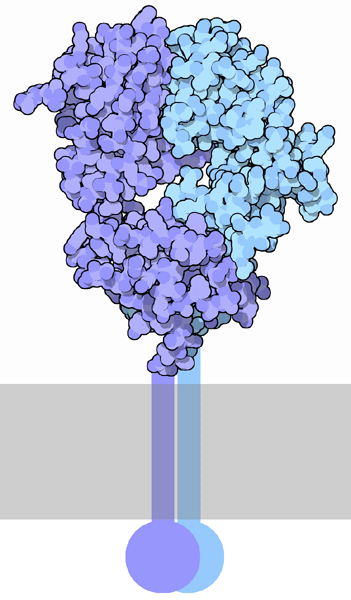|
Inhaltsübersicht | Nanomaschinen | Moleküle | Programme | Kurse | Fun | Links |
||
| > |
T-Cell Receptor

Viruses are one of the major dangers that we face in everyday life, so our immune system has powerful methods to fight them. Our cells call for help when they become infected, by displaying little pieces of the viruses on their surface. When the immune system finds these viral peptides, it quickly kills the infected cell and the viruses inside. Last month, we saw how an infected cell displays viral peptides using MHC. This month, we will look at the T-cell receptor, the protein that recognizes these viral peptides.
Virus Patrol
Cytotoxic T-cells are the police force that patrols the body looking for infected cells. T-cell receptors on the surface of T-cells bind tightly to viral peptides displayed in MHC. Each T-cell has its own type of T-cell receptor, which recognizes its own type of peptide. The immune system creates a diverse collection of different of T-cells, each with a different receptor, so we are protected from many different types of infection. These different types of T-cells are created as the T-cells mature. As a stem cell changes into a T-cell, it shuffles around its genes to form a random, unique T-cell receptor. Then, through a process of selection in the thymus, all of the T-cells that happen to recognize our own normal proteins are destroyed, leaving only those that recognize foreign objects.Antibody Arms
T-cell receptors, like the one shown here from PDB entry 1tcr, are similar to one arm of an antibody. Like antibodies, they are composed of two chains. The binding site is at the tip of the molecule, and is formed of by several loops of the protein chains. The amino acids in these loops are very different in different T-cell receptors, so they are often called hypervariable loops. Each chain also includes a segment at one end that crosses through the membrane, connecting the receptor to the cell surface. These portions are shown schematically here, since they were removed when the crystal structure was solved.T-Cells and AIDS
The importance of this system becomes clear when we look at what happens when it is gone. HIV preferentially infects T-cells, attacking the very system that protects us from viruses. Without treatment, the virus steadily attacks T-cells, depleting the immune system. When the number of T-cells gets too low, the infected individual progresses into AIDS. Then they are susceptible to many infections, since the immune system is no longer strong enough to fight off the invaders.Next: A Molecular Handshake
Last changed by: A.Honegger,